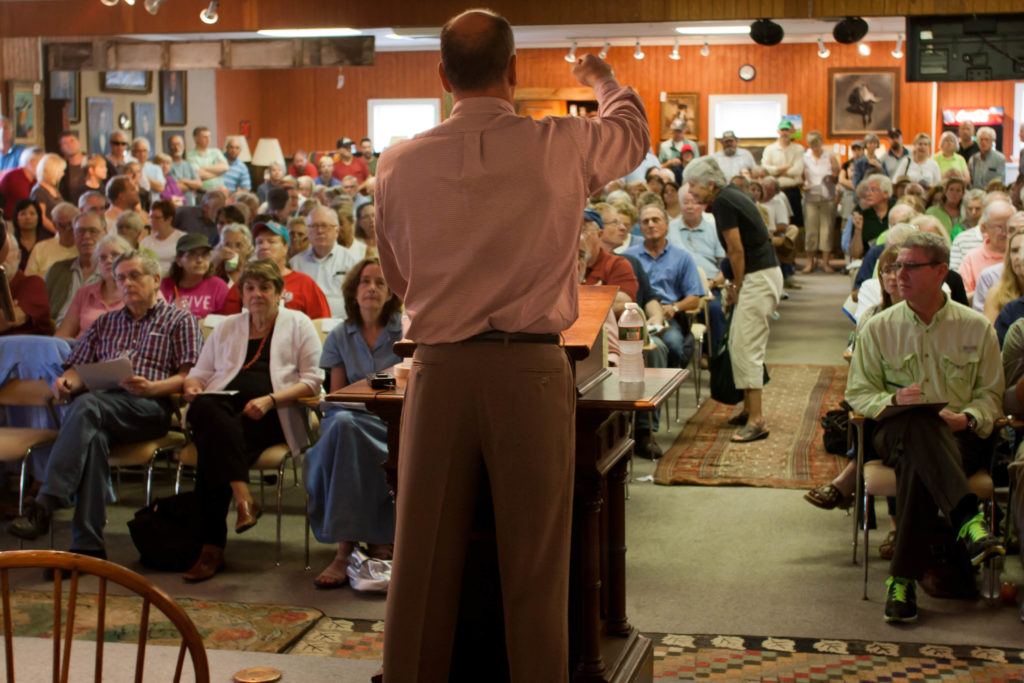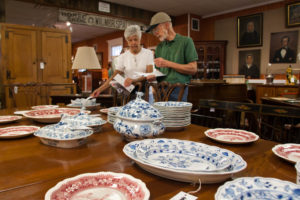 No, that’s not the recipe for a Dartmouth College fraternity party, it’s auction time at Smith’s Auction Gallery in Plainfield, NH, an old school New England auction house where computer bidding is unheard of, but where a brisk business is being done in donuts and coffee as hundreds of potential buyers cram into the gallery to find their reserved seats. Eventually the crowd will spill out onto the back porch where a barbecue is set up to serve lunch later in the day. Many determined bidders are back after spending the previous day at the preview kicking the tires (sometimes literally) on the almost 700 lots that are up for sale. That is just one of the beauties of a “real” auction: unlike on eBay, you get to touch the upholstery, smell the varnish and examine closely the signatures on paintings and the dove tail joints on low boys.
No, that’s not the recipe for a Dartmouth College fraternity party, it’s auction time at Smith’s Auction Gallery in Plainfield, NH, an old school New England auction house where computer bidding is unheard of, but where a brisk business is being done in donuts and coffee as hundreds of potential buyers cram into the gallery to find their reserved seats. Eventually the crowd will spill out onto the back porch where a barbecue is set up to serve lunch later in the day. Many determined bidders are back after spending the previous day at the preview kicking the tires (sometimes literally) on the almost 700 lots that are up for sale. That is just one of the beauties of a “real” auction: unlike on eBay, you get to touch the upholstery, smell the varnish and examine closely the signatures on paintings and the dove tail joints on low boys.
The novelty value of eBay has worn off; people are no longer getting the same buzz they did ten years ago from an online bidding war for an exotic item offered by a faceless seller across the country. But entering a real auction gallery such as Smith’s is like stepping into Aladdin’s cave: treasures everywhere; sculptures, rifles, porcelain and old signs. Indeed, the catalog for this auction is a cornucopia of goods, from diamond rings to paintings and huge oriental rugs. And, yes, it is a mixed bag – some stuff will go for seventy five bucks, while the choice items that anchor the auction will make their way well into six figures. After evaluating the merchandise, the big question for everyone at an auction, is, of course: how much would I be willing to pay for this particular item and still consider it a good deal?
 “There are no bargains here,” an art dealer from Windsor, VT, declares with a shrug, as he takes a break from exchanging trade gossip with a colleague while watching the unfolding auction out of the corner of his eye. “You get a lot of retail here,” quips another, “people with second homes that need filling.” For someone like him, the presence of well-heeled individual buyers is a setback, since they are likely willing to pay more than he can afford to bid with an eye for resale, and that pushes up the prices. But for the seller and for the auction house, that’s good news, of course. Retail or not, there are lots of dealers in the room, and while some may have come mainly to watch the action and get a sense of the market, many of them are also placing bids.
“There are no bargains here,” an art dealer from Windsor, VT, declares with a shrug, as he takes a break from exchanging trade gossip with a colleague while watching the unfolding auction out of the corner of his eye. “You get a lot of retail here,” quips another, “people with second homes that need filling.” For someone like him, the presence of well-heeled individual buyers is a setback, since they are likely willing to pay more than he can afford to bid with an eye for resale, and that pushes up the prices. But for the seller and for the auction house, that’s good news, of course. Retail or not, there are lots of dealers in the room, and while some may have come mainly to watch the action and get a sense of the market, many of them are also placing bids.
That leaves the the collectors – one bidder waits patiently on the back porch for hours, then nips in and successfully bids $250 on an old derringer – the second home owners, and other regular people who simply have “a thing” for antiques. That would be someone like Carl Franco from Connecticut, who is here looking for a couple of paintings and has a couple of things circled in the catalog. He’s makes a point to attend auctions at Smith’s gallery if he’s in the area. Another guy is here looking for presents – mostly jewelry, he figures – while a guy who normally comes to auctions looking for that kind of small stuff has decided that he’s going to bid on a couple of oriental rugs today.
Many of them have played this game for decades, and have the demeanor of hardened poker players, scrutinizing the competition, analyzing the bidding, noting down final bids in the margin of their dog-eared catalogs. They’re mostly older, and the overall impression of the crowd is an eclectic mix of slightly eccentric bohemians and honest, salt-of-the-earth penny pinchers. There’s not a tie in sight – indeed, apart from the auctioneer, nobody in the gallery appears to have dressed for the occasion. It’s not about us, it’s all about the stuff – we haven’t come to look at each other, we’ve come to look at what’s for sale. That’s quite refreshing, really, and surely makes it less intimidating for those unfamiliar with the rest of the protocols of the live auction format.
This, then, is the traditional New England country auction format that Smith’s knows to do so well and has perfected over almost fifty years: part bazaar, part show, part serious business. You start with this ungodly amount of items that may or may not be of value to someone else. The job of the auction house is to sort through it all and separate the wheat from the chaff, organize it, and present it well. In the case of an entire estate there may be a lot of mediocre things to unload in order to be able to showcase a few choice items.
Then comes the real auction action: a good auctioneer combines an incredible knowledge of styles and art history with the showmanship and charm required to entice reluctant buyers forward with a bid. “Provenance is key,” says gallery owner Bill Smith. “Having the story behind an item is one thing that can really make a huge difference in the price at a sale.” Knowing many of the buyers by name from decades in the business probably helps, too. Time and again during the auction, Bill will call out individual bidders and playfully entice them to bid with what appears to be a detailed memory of their buying history and preferences.
A stunning Cadillac from the 1930s is on the block now. Bill gives a quick history of the car, then starts taking bids. The eight hour marathon auction leaves less than a minute per lot, so even though the car is a fairly big ticket item, the gavel comes down about as fast as for the countless small framed portraits and pieces of silverware in the catalog. A flurry of back-and-forth bidding across the room, and the car is sold. The next item is brought forward by the army of gallery workers straining to keep up with the pace. It’s a beautifully choreographed display where the props can be yours at a price that you can help set.
At the end of the day a traditional auction is about carefully nurturing the a group of buyers to act on their inclination to pay top dollar for unique and hard-to-find items with character, history and cultural heritage. So, It is basically a match making service for antiques, and regardless of whether you’re a buyer, seller, dealer or simply a spectator on the sidelines, it’s an entertaining, thrilling, and entirely fascinating way to do business.